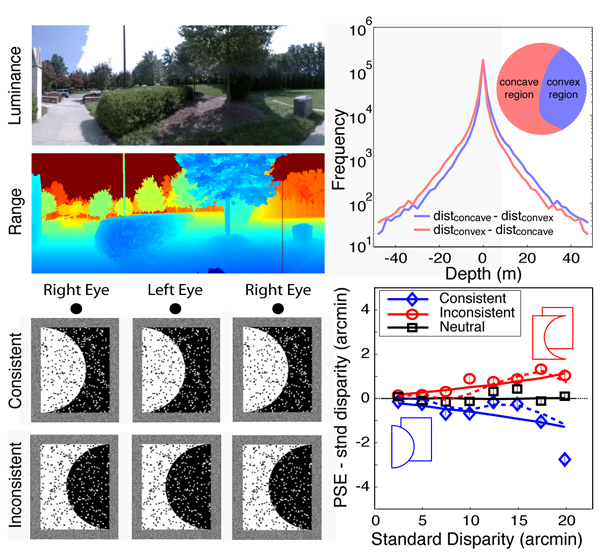
background
For the past hundred years, figure-ground cues (e.g. convexity, area,
surroundedness, lower region, familiarity) have been known to affect
judgments of which region is “figure” and which is “ground” . Put
another way, the shape of the contour influences which region is seen
to be the occluding surface and which is seen to be the occluded
surface. For nearly this entire period, it has been assumed that
figure-ground cues provide only "ordinal depth information"-
information about which imaged surface is nearer, but nothing about
how much the surfaces are separated in depth. However, recent findings
have established that figure-ground cues can affect percepts of
"metric depth"- how far two surfaces are separated in depth- when
another metric depth cues is present (Burge, Peterson, & Palmer, 2005;
Bertamini et al, 2008). This result is surprising because ordinal
depth information constrains only the sign of depth between pairs of
surfaces, so the ordinal cue is either consistent with the metric cue
and provides no additional numerical information, or the cues are
inconsistent and it is not obvious how to resolve the conflict.
We reexamined the depth information provided by convexity in the
natural environment by performing a statistical analysis of natural
scenes. We found that i) metric depth information is available from
the shape of image regions and ii) that depth steps across surfaces
with convex silhouettes are likely to be larger than depth steps
across surfaces with concave silhouettes. Even though there is no
geometric relationship between the shape of an occluder's silhouette
and metric depth, there exists a probabilistic relationship,
presumably because most objects are globally convex.
To find out if humans exploit this relationship we performed a
psychophysical experiment. For a given metric depth signaled by
binocular disparity, observers perceived more depth when the near
surface’s silhouette was convex rather than concave. We estimated the
depth distributions observers used in making those judgments: They
were similar to the natural-scene distributions. Our findings show
that convexity should be reclassified as a quantitative depth cue.
They also suggest that the dichotomy between metric and non-metric
depth cues is a false one and that many, perhaps all, cues should be
evaluated with respect to natural-scene statistics. Finally, the
findings provide an ecological explanation for why figure-ground cues
modulate disparity-sensitive cells in visual cortex.



